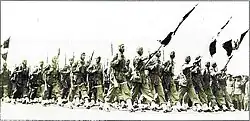Paratrooper Company
| Historic Company "72nd Paratrooper Squadron" | |
|---|---|
 Members of the unit marching in Lima | |
| Active | 1939 – present |
| Country | |
| Branch | Peruvian Air Force[a] |
| Type | Light infantry Airborne infantry |
| Garrison/HQ | Las Palmas Air Base |
| Engagements | Ecuadorian–Peruvian War |
| Commander | Cpt. Augusto Duarte Colichón[2] 2nd Lt. Jesús Polar Valdivia[3] |
The Historic Company "72nd Paratrooper Squadron" (Spanish: Compañía Histórica "72 Escuadrilla de Paracaidistas"),[4] formerly simply the Paratrooper Company (Spanish: Compañía de Paracaidistas), is the paratroop branch of the Peruvian Air Force, based in Las Palmas Air Base.[5]
Formed in 1939, it saw combat during the Ecuadorian–Peruvian War, when it seized the Ecuadorian port city of Puerto Bolívar on 27 July 1941, marking the first time in the Americas that airborne troops were used in combat.[6]
History
Background
On 27 March 1927, Enrique Tavernie Entelador became the first Peruvian paratrooper when he leapt from an Avro aircraft, piloted by Captain Clifford, from a height of 2,000 meters over Las Palmas Air Base (then Las Palmas Aerodrome).[7] Subsequently, on 10 May 1928, Second Lieutenant César Álvarez Guerra voluntarily jumped from a height of 3,000 meters, becoming the first military paratrooper.[8] Major Fernando Melgar Conde and Sergeant 1st. Jose Pineda Castro followed on 16 May 1928, when they jumped over Las Palmas at altitudes of 2,000 and 4,300 meters, respectively. On 24 May of that year, Ensign Peter Griva, of the seaplane service from Ancon, jumped from a height of 2,000 meters.
Formation
The first Parachute School opened in 1939, with now Colonel Guerra in command. José Quiñones attended this school.[8][9] In the same year the unit was formed.[6]
On 14 November 1940, Sgt. Lázaro Orrego became the first casualty of the unit when his parachute failed to open while doing exercises in Ancón.[10]
Ecuadorian–Peruvian War
The unit became well known during the Ecuadorian–Peruvian War when paratroopers Antonio Brandariz Ulloa, Carlos Raffo García and Armando Orozco seized the city of Puerto Bolívar in southern Ecuador prior to the declaration of a ceasefire on July 31, 1941, concluding the Peruvian offensive in El Oro Province.[2]
Later history
The unit has marched in its traditional grey uniform as part of the Air Force's troops during the Grand Military Parade held annually.[4][5]
See also
- History of Paratrooping
- Sinchis, a similar unit of the National Police of Peru, formerly the Civil Guard.
Notes
References
- ^ "Fuerza Aérea del Perú se hizo presente en Gran Parada Cívico Militar por Fiestas Patrias". Andina (in Spanish). Lima. 29 July 2012. Retrieved 26 February 2022.
- ^ a b Julca-Núñez, Héctor (2017). Vencedores del 41: Campaña Militar Contra Ecuador (PDF) (in Spanish). Piura: University of Piura. pp. 61, 108–110. Retrieved 26 February 2022.
- ^ Nomberto, Víctor R. (8 August 2016). "Guerra de 1941". Pontifical Catholic University of Peru (in Spanish). Retrieved 26 February 2022.
- ^ a b "Herederos de capitán FAP Quiñones desfilaron con gallardía en Parada Militar". Andina. 29 July 2018.
- ^ a b "Compañía Histórica de Paracaidistas FAP desfilará después de muchos años en Parada Militar". Andina. 8 December 2009.
- ^ a b "El CAP en la guerra con el Ecuador en 1941". Oocities.org (in Spanish). Retrieved 9 December 2012.
- ^ "Paracaidismo en el Perú: una historia de coraje, vidas salvadas y defensa del país a lo largo de 94 años". moyobamba.com (in Spanish). 26 March 2021. Retrieved 17 May 2023.
- ^ a b Theotokis, Nikolaos (2020). Airborne Landing to Air Assault: A History of Military Parachuting. Pen and Sword Books. pp. 137–138. ISBN 9781526747020. Retrieved 26 February 2022.
- ^ "Héroe Nacional Capitán FAP José Abelardo Quiñones Gonzales, Gran General del Aire del Perú". Peruvian Air Force (in Spanish). Retrieved 26 February 2022.
- ^ "Sargento FAP Lázaro Orrego Morales". Peruvian Air Force (in Spanish). Retrieved 26 February 2022.